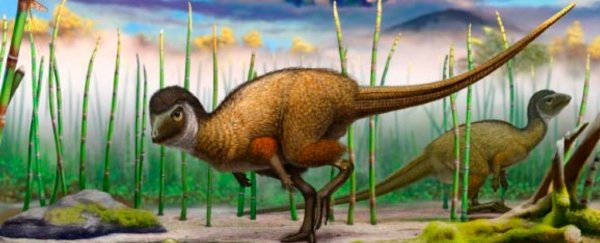Feathers are not simply the domain of birds, nor did they arise solely for flight. New research on China's rich fossil record suggests instead that these structures arose 100 million years before birds, and maybe even before dinosaurs themselves.
The breakthrough came late last year, when researchers were studying two new fossilised pterosaurs in China. Once considered scaly and reptilian, these prehistoric flying reptiles (closely related to dinosaurs), were covered in four kinds of tuft and down.
Pterosaurs, it would seem, had feathers remarkably similar to their dinosaur relatives. They must have had a common ancestor.
"This drives the origin of feathers back to 250 million years ago at least. The point of origin of pterosaurs, dinosaurs and their relatives," says lead author Mike Benton, a palaeontologist from the University of Bristol.
"The Early Triassic world then was recovering from the most devastating mass extinction ever, and life on land had come back from near-total wipe-out."
As this places the origin of feathers way back in the Early Triassic, it means feathers appeared long before the first birds, such as Archaeopteryx, came on the scene. This was a time of evolutionary turmoil, when the ancestors of dinosaurs, known as archosaurs, were in a fierce arms-race with the ancestors of mammals.
Feathers probably arose to help in the contest, providing insulation in the warm-blooded precursors of dinosaurs and pterosaurs. Only afterwards would these structures have been used for display or flight.
"[T]hus," they authors write, "the small dinosaurian ancestors of birds were pre-adapted for a life as active flyers."
 (Yuan Zhang)
(Yuan Zhang)
Ever since 1994, when thousands of dinosaur specimens from China were found with feathers, palaeontologists have been grappling with the revolutionary idea.
"At first, the dinosaurs with feathers were close to the origin of birds in the evolutionary tree," explains co-author Baoyu Jiang from the University of Nanjing.
"This was not so hard to believe. So, the origin of feathers was pushed back at least to the origin of those bird-like dinosaurs, maybe 200 million years ago."
Then, a dinosaur from Russia named Kulindadromeus broke the main rule that glued this theory together.
"This dinosaur showed amazingly well-preserved skin covered with scales on the legs and tail, and strange whiskery feathers all over its body," recalls co-author Maria McNamara from University College Cork.
"What surprised people was that this was a dinosaur that was as far from birds in the evolutionary tree as could be imagined. Perhaps feathers were present in the very first dinosaurs."
 (Benton et al., Trends in Ecology and Evolution, 2019)
(Benton et al., Trends in Ecology and Evolution, 2019)
Not all paleontologists agree that feathers come from a single origin. Some think they arose independently in both birds and dinosaurs. But the new analysis suggests otherwise.
Apart from recent palaeontology research, the findings are also bolstered by genetics. In 2017, a study found that the same genome regulatory network drove the development of reptile scales, bird feathers, and mammal hairs.
In other words, the root of all three structures may have been present in a common ancestor that existed up to 420 million years ago.
How exactly all three fit together in the evolutionary tree is still unclear. Scientists have shown that the scales on modern birds, such as the legs and necks of chickens, are feathers that have reversed to scales.
This suggests that feathers might have been a default condition for dinosaurs, which was only later suppressed in large, armoured members of the group.
"This does not diminish the importance of feathers as key to the success of birds," Benton and his co-authors write, "but shows that birds did not emerge rapidly from reptiles, but that their set of 30 or more adaptations accumulated stepwise over some 100 [million years]."
The research has been published in Trends in Ecology and Evolution.
